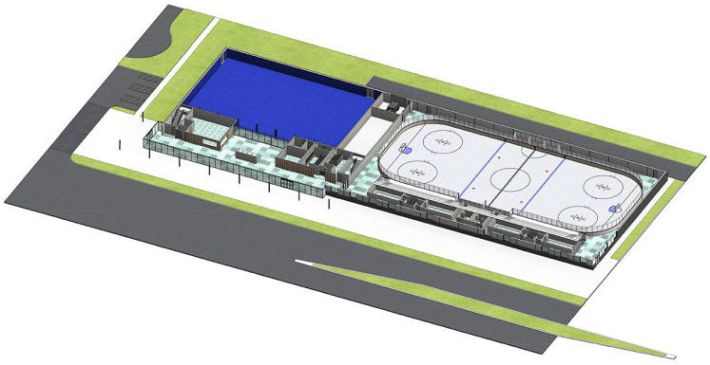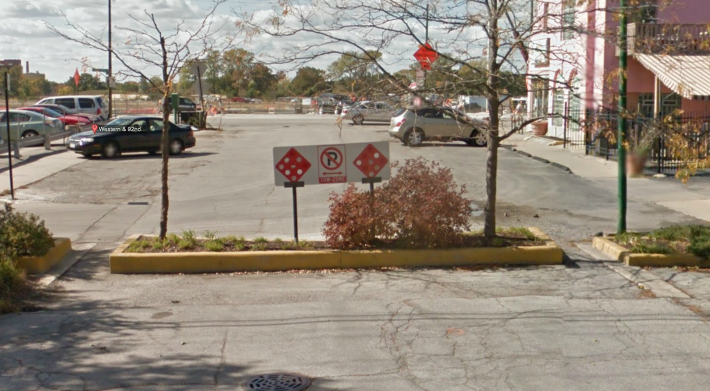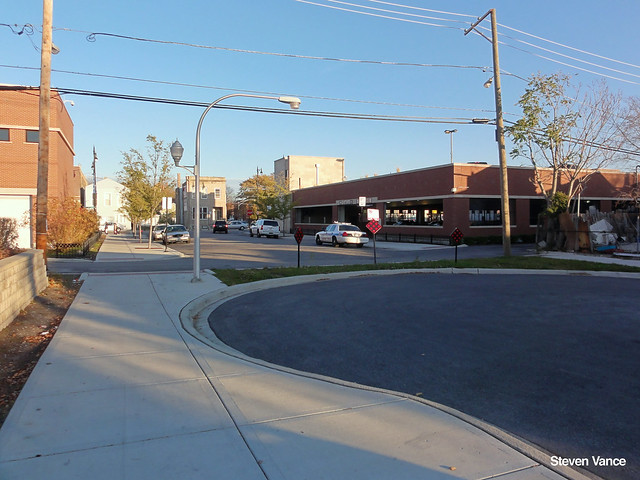
The Chicago Department of Transportation will close 115th Street just east of Western Avenue to motor vehicle through traffic, creating a cul-de-sac to reduce neighborhood traffic after a Chicago Park District ice hockey rink and gymnastics center opens. The closure for cars could improve this important bike route, but only if it maintains street connectivity for bicycling, which doesn't seem to be the case in previous designs and project renderings.
Images presented at a community meeting last year show no indication that people will be able to bicycle through the cul-de-sac. Sidewalks are unimpeded, but adding a new curb and filling in the roadbed will inhibit bicycle use on what some residents consider the best east-west bicycling route in the 19th Ward.
There are dozens of cul-de-sacs in the ward designed to limit turning movements to and from 95th Street. Other cul-de-sacs built around Chicago are installed for similar reasons, and force bicyclists to use sidewalks.
Anne Alt, who lives nearby and rides a bike in this neighborhood, emailed 19th Ward Alderman Matt O'Shea, CDOT, and the Active Transportation Alliance to express her concern that nothing be done to impede this great bike route. She wrote:
Both 111th and 119th are hazardous to cyclists, so 115th has frequently been used by cyclists seeking a safe crossing of Western at a controlled intersection. For pedestrians, crossing Western anywhere except at a stoplight is also a hazardous proposition. 115th St. is a critical crossing for both pedestrians and cyclists.
On the same thread, Active Transportation Alliance board member Jane Healy, who leads kids' bike rides from Blue Island, echoed Alt's concern, saying she leads three to six bike rides a month through this intersection.
A traffic study indirectly underscored the potential of 115th as a bike route. The street was closed temporarily last fall, causing 60 percent of drivers to divert to 111th and 119th. With fewer people driving on the street, it will be even more appealing for biking.
Alt added that she hopes the city's complete streets policy, a simple paragraph adopted in the mid-2000s that blossomed into the potentially powerful Complete Streets Design Guidelines last year, "will be respected and implemented." The design guidelines are written to ensure that the mobility and access of people walking, biking, and using transit take precedence over moving cars.
Alt told me that the cul-de-sacs and traffic diverters in the 19th Ward vary: Many are missing bicycle cut-throughs and the ones that have openings are very narrow, have uneven pavement, or are filled with debris. Others have shrubs so large that they "block passage." Upon close inspection it seems some of the openings are there more for stormwater flow in the gutter than as cut-throughs for bicyclists.

A modern cul-de-sac built in Bridgeport in 2008 has no opening, for bicyclists or the gutter, despite CDOT's own street design standards from 2007 [PDF] saying that cul-de-sacs should have "through access for bicyclists, with appropriate curb cuts, markings, and signing."
A Chicago Park District project manager responded to some of the points in Alt's email, saying the "closure is specific to vehicle traffic" and that bicycle and pedestrian traffic will still be able to pass through, but so far, the known project details don't inspire confidence that the Complete Streets Design Guidelines will be well-implemented at this site.
Alt pointed out that "most of the existing traffic barriers (cul de sacs and diverters) in our ward are not very bike friendly." Alderman O'Shea agreed to relay all of her points to the project manager but gave no indication that bike access will be a priority for him:
I will tell you that this site will be designed to maximize parking spaces. If we can do so in a way that also allows for the issues you outlined below we will certainly do so. Unfortunately, the biggest concern residents currently have related to this project is adequate parking. As such, that will be our top priority in determining a final site plan.
The Chicago Park District project manager notified Alt that they plan to build 16 bike parking spaces. This low number (there will be 74 to 130 space-gobbling car parking spaces), along with the vague assurances of bicycle access, isn't enough to meet the city's goals to encourage bicycling for short trips. Nor will it take advantage of the expected changing traffic pattern in Morgan Park.
Neither Alderman O'Shea nor CDOT responded to a request for details about how bicyclists will be accommodated in the street closure.





